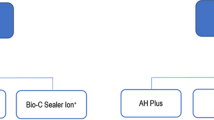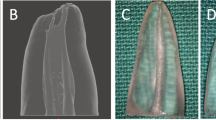Abstract
Objectives
The aim of the present study was to evaluate the adaptation of a calcium silicate bioceramic (BC) sealer with either BC or conventional gutta-percha compared with that of AH Plus sealer in different root canal sections.
Materials and methods
Seventy-two extracted mandibular premolars were divided randomly into six groups. After standardised chemomechanical preparation, four groups were obturated with the BC sealer and BC gutta-percha or conventional gutta-percha, and the other two groups were obturated with AH Plus sealer and conventional gutta-percha either in lateral compaction or in a single cone technique. Each root was sectioned into three sections. An impression was made from each section, and replicas were then made for scanning electron microscopy (SEM) analysis. Areas and interfacial gaps were identified using image analysis software. In addition to descriptive and explorative data analyses, linear regression analysis was performed.
Results
All specimens had measurable interfacial gaps. Significantly fewer gaps were found between conventional gutta-percha and sealer compared to those observed when using the BC gutta-percha (p < 0.001). However, minor interfacial gaps between sealer and dentin were observed with the BC sealer (p = 0.04). The technique of obturation in different root canal sections did not significantly affect the sealer adaptability.
Conclusion
The type of gutta-percha as well as the sealer had a noticeable impact on the adaptability.
Clinical relevance
Different obturation techniques will result in similar outcomes. However, within the limitations of the study, there seems to be no advantage in using the BC gutta-percha.

Similar content being viewed by others
References
Schilder H (1967) Filling root canals in three dimensions. Dent Clin N Am 11:723–744
Hwang JH, Chung J, Na H-S, Park E, Kwak S, Kim H-C (2015) Comparison of bacterial leakage resistance of various root canal filling materials and methods: confocal laser-scanning microscope study. Scanning 37:422–428
Wang Z (2015) Bioceramic materials in endodontics. Endod Top 32:3–30
Michaïlesco PM, Valcarcel J, Grieve AR, Levallois B, Lerner D (1996) Bacterial leakage in endodontics: an improved method for quantification. J Endod 22:535–539
Ørstavik D (2014) Endodontic filling materials. Endod Top 31:53–67
Grossman LI (1981) Endodontic practice, 10th edn. Henry Kimpton, Philadelphia
Schwartz RS (2006) Adhesive dentistry and endodontics. Part 2: bonding in the root canal system—the promise and the problems: a review. J Endod 32:1125–1134
Trope M, Bunes A, Debelian G (2015) Root filling materials and techniques: bioceramics a new hope? Endod Top 32:86–96
DeLong C, He J, Woodmansey KF (2015) The effect of obturation technique on the push-out bond strength of calcium silicate sealers. J Endod 41:385–388
Kahn FH, Rosenberg PA, Schertzer L, Korthals G, Nguyen PN (1997) An in-vitro evaluation of sealer placement methods. Int Endod J 30:181–186
Neelakantan P, Varughese AA, Sharma S, Subbarao CV, Zehnder M, De-Deus G (2012) Continuous chelation irrigation improves the adhesion of epoxy resin-based root canal sealer to root dentine. Int Endod J 45:1097–1102
Shokouhinejad N, Gorjestani H, Nasseh AA, Hoseini A, Mohammadi M, Shamshiri AR (2013) Push-out bond strength of gutta-percha with a new bioceramic sealer in the presence or absence of smear layer. Aust Endod J 39:102–106
Moinzadeh AT, Mirmohammadi H, Veenema T, Kleverlaan CJ, Wesselink PR, Wu MK, Shemesh H (2014) Effect of a two-step placement procedure on the dislocation resistance of a methacrylate resin-based root canal sealer: a proof of concept. J Adhes Dent 16:567–574
Wu MK, R'Oris A, Barkis D, Wesselink PR (2000) Prevalence and extent of long oval canals in the apical third. Oral Surg Oral Med Oral Pathol Oral Radiol Endod 89:739–743
Selem LC, Li GH, Niu LN, Bergeron BE, Bortoluzzi EA, Chen JH, Pashley DH, Tay FR (2014) Quality of obturation achieved by a non-gutta-percha-based root filling system in single-rooted canals. J Endod 40:2003–2008
Ørstavik D, Nordahl I, Tibballs JE (2001) Dimensional change following setting of root canal sealer materials. Dent Mater 17:512–519
Ghoneim AG, Lutfy RA, Sabet NE, Fayyad DM (2011) Resistance to fracture of roots obturated with novel canal-filling systems. J Endod 37:1590–1592
Li GH, Niu LN, Zhang W, Olsen M, De-Deus G, Eid AA, Chen JH, Pashley DH, Tay FR (2014) Ability of new obturation materials to improve the seal of the root canal system: a review. Acta Biomater 10:1050–1063
Tay FR, Pashley DH (2007) Monoblocks in root canals—a hypothetical or a tangible goal. J Endod 33:391–398
Belli S, Eraslan O, Eskitascioglu G, Karbhari V (2011) Monoblocks in root canals: a finite elemental stress analysis study. Int Endod J 44:817–826
Zhang W, Li Z, Peng B (2010) Assessment of a new root canal sealer’s apical sealing ability. Oral Surg Oral Med Oral Pathol 107:e79–e82
Atmeh AR, Chong EZ, Richard G, Festy F, Watson TF (2012) Dentin-cement interfacial interaction: calcium silicates and polyalkenoates. J Dent Res 91:454–459
McMichael GE, Primus CM, Opperman LA (2016) Dentinal tubule penetration of tricalcium silicate sealers. J Endod 42:632–636
Al-Haddad A, Abu Kasim NH, Che Ab Aziz ZA (2015) Interfacial adaptation and thickness of bioceramic-based root canal sealers. Dent Mater J 34:516–521
Tay FR, Loushine RJ, Lambrechts P, Weller RN, Pashley DH (2005) Geometric factors affecting dentin bonding in root canals: a theoretical modeling approach. J Endod 31:584–589
Weis MV, Parashos P, Messer HH (2004) Effect of obturation technique on sealer cement thickness and dentinal tubule penetration. Int Endod J 37:653–663
Wu MK, Kast'akova A, Wesselink PR (2001) Quality of cold and warm gutta-percha fillings in oval canals in mandibular premolars. Int Endod J 34:485–491
Nica LM, Didilescu A, Rusu D, Bacila A, Stratul SI (2012) Photomicrographic evaluation of the apical sealing capacity of three types of gutta-percha master cones: an in vitro study. Odontology 100:54–60
Lee KW, Williams MC, Camps JJ, Pashley DH (2002) Adhesion of endodontic sealers to dentin and gutta-percha. J Endod 28:684–688
Endodontics. EBotJo (2007) Wanted: a base of evidence. J Endod 33:1401–1402
De-Deus G (2012) Research that matters—root canal filling and leakage studies. Int Endod J 45:1063–1064
Zaslansky P, Fratzl P, Rack A, Wu MK, Wesselink PR, Shemesh H (2011) Identification of root filling interfaces by microscopy and tomography methods. Int Endod J 44:395–401
Xuereb M, Vella P, Damidot D, Sammut CV, Camilleri J (2015) In situ assessment of the setting of tricalcium silicate-based sealers using a dentin pressure model. J Endod 41:111–124
Viapiana R, Moinzadeh AT, Camilleri L, Wesselink PR, Tanomaru Filho M, Camilleri J (2016) Porosity and sealing ability of root fillings with gutta-percha and BioRoot RCS or AH Plus sealers. Evaluation by three ex vivo methods. Int Endod J 49:774–782
Torabinejad M, Smith PW, Kettering JD, Pitt Ford TR (1995) Comparative investigation of marginal adaptation of mineral trioxide aggregate and other commonly used root-end filling materials. J Endod 21:295–299
Abdal AK, Retief DH (1982) The apical seal via the retrosurgical approach. I.A. preliminary study. Oral Surg Oral Med Oral Pathol 53:614–621
Funding
This study was not funded.
Author information
Authors and Affiliations
Corresponding author
Ethics declarations
Conflicts of interest
The authors declare that they have no conflicts of interest.
Ethical approval
This article does not contain any studies with human participants or animals performed by any of the authors. All procedures performed in this study were performed in accordance with the ethical standards of the institutional and/or national research committee.
Rights and permissions
About this article
Cite this article
Eltair, M., Pitchika, V., Hickel, R. et al. Evaluation of the interface between gutta-percha and two types of sealers using scanning electron microscopy (SEM). Clin Oral Invest 22, 1631–1639 (2018). https://doi.org/10.1007/s00784-017-2216-x
Received:
Accepted:
Published:
Issue Date:
DOI: https://doi.org/10.1007/s00784-017-2216-x




